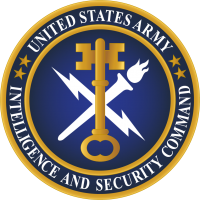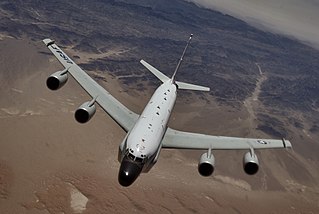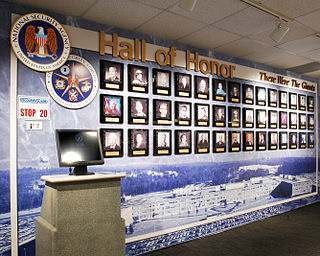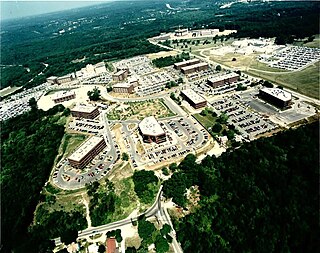
The National Security Agency (NSA) is a national-level intelligence agency of the United States Department of Defense, under the authority of the Director of National Intelligence (DNI). The NSA is responsible for global monitoring, collection, and processing of information and data for foreign and domestic intelligence and counterintelligence purposes, specializing in a discipline known as signals intelligence (SIGINT). The NSA is also tasked with the protection of U.S. communications networks and information systems. The NSA relies on a variety of measures to accomplish its mission, the majority of which are clandestine. The existence of the NSA was not revealed until 1975. The NSA has roughly 32,000 employees.

Signals intelligence (SIGINT) is intelligence-gathering by interception of signals, whether communications between people or from electronic signals not directly used in communication. Signals intelligence is a subset of intelligence collection management. As classified and sensitive information is usually encrypted, signals intelligence in turn involves the use of cryptanalysis to decipher the messages. Traffic analysis—the study of who is signaling whom and in what quantity—is also used to integrate information again.

Australian Signals Directorate (ASD), formerly the Defence Signals Directorate (DSD) is the federal statutory agency in the Australian Government responsible for foreign signals intelligence, support to military operations, cyber warfare, and information security. ASD is part of the Australian Intelligence Community. ASD's role within UKUSA Agreement is to monitor signals intelligence ("SIGINT") in South and East Asia. The ASD also houses the Australian Cyber Security Centre.

The Communications Security Establishment, formerly called the Communications Security Establishment Canada (CSEC), is the Government of Canada's national cryptologic agency. It is responsible for foreign signals intelligence (SIGINT) and communications security (COMSEC), protecting federal government electronic information and communication networks, and is the technical authority for cyber security and information assurance.

The National Reconnaissance Office (NRO) is a member of the United States Intelligence Community and an agency of the United States Department of Defense which designs, builds, launches, and operates the reconnaissance satellites of the U.S. federal government, and provides satellite intelligence to several government agencies, particularly signals intelligence (SIGINT) to the NSA, imagery intelligence (IMINT) to the NGA, and measurement and signature intelligence (MASINT) to the DIA.

The Central Security Service (CSS) is a combat support agency of the United States Department of Defense which was established in 1972 to integrate the National Security Agency (NSA) and the Service Cryptologic Components (SCC) of the United States Armed Forces in the field of signals intelligence, cryptology, and information assurance at the tactical level. In 2002, the CSS had approximately 25,000 uniformed members. It is part of the United States Intelligence Community.

Project MINARET was a domestic espionage project operated by the National Security Agency (NSA), which, after intercepting electronic communications that contained the names of predesignated US citizens, passed them to other government law enforcement and intelligence organizations. Intercepted messages were disseminated to the FBI, CIA, Secret Service, Bureau of Narcotics and Dangerous Drugs (BNDD), and the Department of Defense. The project was a sister project to Project SHAMROCK.
Unit 8200 is an Israeli Intelligence Corps unit of the Israel Defense Forces responsible for clandestine operation, collecting signal intelligence (SIGINT) and code decryption, counterintelligence, cyberwarfare, military intelligence, and surveillance. Military publications include references to Unit 8200 as the Central Collection Unit of the Intelligence Corps, and it is sometimes referred to as Israeli SIGINT National Unit (ISNU). It is subordinate to Aman, the military intelligence directorate.
The NSA/CSS Texas Cryptologic Center (TCC), also known as the Texas Cryptology Center, Texas Cryptographic Center or NSA Texas, is a satellite campus at the Medina Annex, Lackland Air Force Base, San Antonio, Texas, operated by the U.S. National Security Agency (NSA). It is adjacent to the former Medina National Stockpile Site. TCC conducts signals intelligence, cyberwarfare operations and cybersecurity operations.

The United States Army Intelligence and Security Command (INSCOM) is a direct reporting unit that conducts intelligence, security, and information operations for United States Army commanders, partners in the Intelligence Community, and national decision-makers. INSCOM is headquartered at Fort Belvoir, Virginia.
Signals intelligence by alliances, nations and industries comprises signals intelligence (SIGINT) gathering activities by national and non-national entities; these entities are commonly responsible for communications security (COMSEC) as well.

Signals intelligence operational platforms are employed by nations to collect signals intelligence, which is intelligence-gathering by interception of signals, whether between people or between machines, or mixtures of the two. As sensitive information is often encrypted, signals intelligence often involves the use of cryptanalysis. However, traffic analysis—the study of who is signalling whom and in what quantity—can often produce valuable information, even when the messages themselves cannot be decrypted.
National intelligence programs, and, by extension, the overall defenses of nations, are vulnerable to attack. It is the role of intelligence cycle security to protect the process embodied in the intelligence cycle, and that which it defends. A number of disciplines go into protecting the intelligence cycle. One of the challenges is there are a wide range of potential threats, so threat assessment, if complete, is a complex task. Governments try to protect three things:
After the end of World War II, all the Western allies began a rapid drawdown of military forces, including those of signals intelligence. At the time, the US still had a COMINT organization split between the Army and Navy. A 1946 plan listed Russia, China, and a [redacted] country as high-priority targets.

The Hall of Honor is a memorial at the National Security Agency headquarters in Fort Meade, Maryland. It honors individuals who rendered distinguished service to American cryptology.

The Friendship Annex, also known as FANX or FANEX, is a National Security Agency (NSA) facility complex located in Linthicum, Maryland, near the Baltimore Washington International Airport (BWI). Established in the 1970s, the complex consists of multiple buildings and serves multiple roles as a cyber espionage station, electronic intelligence processing facility, and NSA Broadcast Network television studio. It is also the primary campus of the National Cryptologic School.

The Kunia Regional SIGINT Operations Center, also known as the Kunia Tunnel or the Regional Signals Intelligence Operations Center Kunia, was a United States National Security Agency facility that was located on Kunia Road between Kunia Camp and Wheeler Army Airfield in central Oahu, Hawaii. In 2012, the facility was replaced by the Hawaii Cryptologic Center.
The Georgia Cryptologic Center (GCC) or NSA Georgia is a U.S. National Security Agency (NSA) and Central Security Service (CSS) facility located within Fort Gordon, located outside of Augusta, Georgia. The 604,000 sq ft (56,100 m2) facility opened on March 5, 2012, at a cost of $286 million. The GCC's facilities has capacity to employ up to 4,000 personnel. Its primary focus is on signals intelligence intercepts from Europe, the Middle East, and North Africa. The facility is known by the codename "Sweet Tea".
The Hawaii Cryptologic Center (HCC) or NSA Hawaii is a U.S. National Security Agency (NSA) Central Security Service (CSS) facility located near Wahiawa on the island of Oahu, Hawaii. The facility opened on January 6, 2012, at a cost of $358 million. The center focuses on signals intelligence intercepts from Asia, and conducts cybersecurity and cyberwarfare operations.

The National Security Agency (NSA) is a national-level intelligence agency of the Republic of Liberia, under the authority of the President of Liberia. The NSA is responsible for global monitoring, collection, and processing of information and data for foreign intelligence and counterintelligence Liberian communications networks and information systems. The NSA relies on a variety of measures to accomplish its mission, the majority of which are clandestine.














